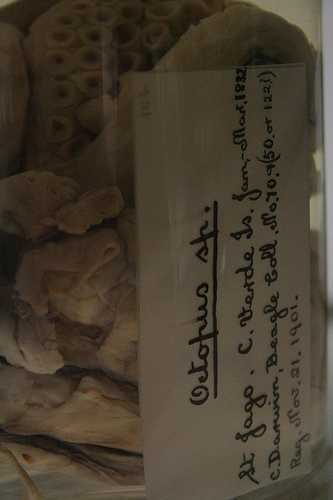Charles Darwin to John Stevens Henslow (18-May-1832):
St Jago [modern-day Porto Praya in the Cape Verde Islands] is singularly barren & produces few plants or insects.—so that my hammer was my usual companion, & in its company most delightful hours I spent.—
On the coast I collected many marine animals chiefly gasteropodous (I think some new).— I examined pretty accurately a Caryophyllea & if my eyes were not bewitched former descriptions have not the slightest resemblance to the animal.— I took several specimens of an Octopus, which possessed a most marvellous power of changing its colours; equalling any chamaelion, & evidently accommodating the changes to the colour of the ground which it passed over.—yellowish green, dark brown & red were the prevailing colours: this fact appears to be new, as far as I can find out.
Darwin was hopelessly wrong about the colour-changing ability of octopuses being a new observation. But never mind: the good news is that one of Darwin's St Jago octopuses is still alive and kicking preserved for posterity in Cambridge, and I have photos to prove it:


Sexy!
Thanks. But how about the octopus?
I thought the octopus was rather sexy - although it was just laying there, not doing much.
Are the labels original, in Darwin's own handwriting?
I'm almost certain that the label isn't Darwin's: his writing was usually a lot more untidy and spidery. It's possible that it might be Henslow's writing, as Henslow took receipt of most of Darwin's specimens from the Beagle voyage. But I'm guessing the writing is actually that of a later curator.
Postscript: According to the book A Voyage Round the World, which I picked up in Cambridge the same day:
In answer to Kevin Z's question in the comments above, I am guessing that the handwriting on the label is that of S. F. Harmer.